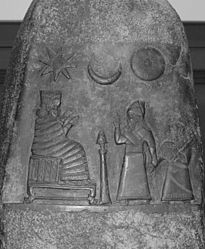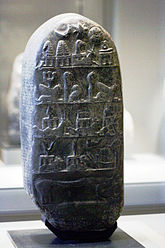- Meli-Shipak II
-
Kudurru of Melishihu at the Louvre
Meli-Šipak II, more often rendered Melišiḫu in contemporary inscriptions, was a Kassite king of Babylon ca. 1186–1172 BC (short chronology). His reign marks the critical synchronization point in the chronology of the Near East.
Contents
His provenance
He is recorded as the son of Adad-šuma-uṣur, his predecessor, on a kudurru.[1] Elsewhere he seemed reluctant to name him in his royal inscriptions, despite Adad-šuma-uṣur’s apparent renown as restorer of Kassite independence, which has been the subject of much speculation amongst historians.[2]
The “II” designation is probably an error caused by over reliance on a single inscription naming one Meli-Šipak, son (=descendant) of Kurigalzu II.[3] He was the last king to bear a wholly Kassite name. Meli means slave,[4] Šipak was a moon god,[5] but Šiḫu was possibly one of the Kassite names for Marduk.
Significance to Near Eastern chronology
At various points in the sequence of Assyrian and Babylonian kings, references are made by one king to their contemporary. Not until the reign of Meli-Šipak, however, do these connections allow a firm placement in time, which has led Malcom Wiener to declare:
Confirmation of the firm foundation of Near Eastern chronology was provided recently by the discovery at Assur of his correspondence with Ninurta-apil-Ekur of Assur (FRAHM n.d.),[6] thus confirming the overlap of these reigns as required by the independent chronologies of Assur and Babylon set forth over thirty years ago by J. Brinkman.[7]—Malcolm H. Wiener, Egypt & TimeThe length of Ninurta-apil-Ekur’s reign is uncertain, as extant copies of the Assyrian King List differ, between three or thirteen years.[8] From the reign of his son and successor, Aššur-dan I, they are consistent, and supported by extant limmu lists from 892 BC on.
Bronze age collapse
His rule is understood to have been peaceful. Not so for the edges of his kingdom, where the catastrophic collapse at the end of the bronze age was starting to dramatically unfold with many of the cities of the Levant experiencing destruction[9] with the city of Emar, situated in northern Syria, which was sacked and where a legal document was found on the floor in a private house there, dated to his second year.[10] The tablet is a short term contract and historian Daniel Arnaud has concluded that only a very short time elapsed between its preparation and the cataclysmic destruction of the city by “hordes of enemies”.[9]
Relations with Elam
One of his daughters, allegedly the eldest, was married to the Elamite ruler Shutruk-Nahhunte. It was the latest in a series of diplomatic marriages between the Kassite rulers of Babylon and the Elamite Kings but was to have unforeseen consequences as it would lead Shutruk-Nahhunte to believe that he had a claim on the Babylonian throne.[11] When he was to later invade and carry away plunder back to Susa, he would have additional inscriptions added to the objects he took in commemoration, for example:
I am Shutruk-Nahhunte, king of Elam. The god Inshushinak gave me the order...The city of Sippur I defeated...I plundered (lit. “brought into my hand”) the Stele of Naram-Sin and brought it back to Elam... The Stele of Meli-Shipak I plundered from [Kassite king] Karaindash and brought back to Elam...[12]—Shutruk Nahhunte, Royal InscriptionThe kudurru tradition
A boundarystone (kudurru) reports of his passing some land with tax exemptions to his son and successor Marduk-apal-iddina I (Land grant to Marduk-apal-iddina).[13] His daughter Ḫunnubat-Nana(ja) was also the recipient of a land grant,[14] which her father had purchased on her behalf, disproving the erstwhile theory of Kassite feudalism that all land belonged to the Monarch.[15]
A kudurru records the lawsuits concerning the estate of Bīt-Takil-ana-ilīšu over three reigns, spanning Adad-šuma-iddina, Adad-šuma-uṣur and Meli-Šipak.[16] This is notable because Meli-Šipak upholds the decisions of both his predecessors, one of whom, Adad-šuma-iddina, may have been merely a vassal king of Assyrian patronage.
The proliferation of the kudurru tradition around this time, suggests increased patronage from a monarch trying to bolster loyalty to his reign, perhaps to counter the problems of legitimacy or instability. A kudurru granting fifty 'gur' of corn-land in the province of Bit-Pir'-Amurri by the king to Ḫa-SAR-du, an official or sukkal mu’irri, may be one such example,[17] and the grant to [Me]li-Ḫala may be another.[3] A tablet records a rikiltu (grant, decree) issued by king Meli-Šipak in his second year of reign to the Sangü and the Satammu (temple administrator) of Ezida, a temple in Borsippa.[18]
See also
For the two boundary stones:
- Kudurru of Melišipak-(Meli-Shipak II)
- Melišipak kudurru-Land grant to Marduk-apal-iddina I-grant to Marduk-apal-iddina I
External links
- Kudurru Image, and Article; (Louvre)
References
- ^ L. W. King (1912). Babylonian Boundary Stones and Memorial-Tablets in the British Museum. British Museum. p. 16. BM 90827, column 4, line 31, but note King’s 1912 edition uses the alternative reading of the cuneiform –MU-ŠEŠ to give Adad-nadin-aḫi.
- ^ Bernard Newgrosh (2007). Chronology at the crossroads: the late bronze age in western Asia. p. 267.
- ^ a b J. A. Brinkman (1976). "* Meli-Šipak". Materials for the Study of Kassite History, Vol. I (MSKH I). Oriental Institute of the University of Chicago. pp. 253–259.
- ^ Arnaud Fournet (June 2011). "The Kassite Language In a Comparative Perspective with Hurrian and Urartean". The Macro-Comparative Journal 2 (1): 13.
- ^ Ahmad Hasan Dani, Jean-Pierre Mohen, J. L. Lorenzo and V. M. Masson, ed (1996). History of Humanity: From the third millennium to the seventh century B.C.. Unesco. p. 479.
- ^ Eckart Frahm, Assur excavations, 2001, (unpublished?) document enumerates teams of horses and rugs sent to Assyria by the Babylonian king Meli-shipak; “13'f., the text states that some of these goods were sent by 1.Mi-li-shi-pak LUGAL KUR Kar-du-ni-ash2 to [Ninurta-apil]-e(sic)-kur LUGAL d.A-shur. The document is badly damaged, like most of the texts unearthed in the "M7 area," and the date formula is broken away.”
- ^ Malcolm H. Wiener (2006). "Egypt & Time". Egypt and the Levant 16: 326.
- ^ Donald John Wiseman (1965). Assyria and Babylonia c. 1200-1000 B. C., Volume 2, Part 31. Cambridge University Press. p. 11.
- ^ a b Robert Drews (1995). The End of the Bronze Age: Changes in Warfare and the Catastrophe ca. 1200 BC. Princeton University Press. pp. 6, 15, 18.
- ^ Edward Lipinski (2006). On the Skirts of Canaan in the Iron Age. Peeters Publishers. p. 28.
- ^ Daniel T. Potts (1999). The archaeology of Elam: formation and transformation of an ancient Iranian State. Cambridge University Press. pp. 207–208.
- ^ Allison Karmel Thomason (2006). Luxury and legitimation: royal collecting in ancient Mesopotamia. Ashgate Pub Co. p. 104.
- ^ Sb 22, found during the French excavations at Susa.
- ^ Sb 23, found with Sb 22 during the French excavations at Susa.
- ^ V. Scheil. Textes élamites-sémitiques, Mémoires de la Délégation en Perse. 10. Paris: Ernest Leroux year = 1908. pp. 87-94. + plates 11-13.
- ^ BM 90827 kudurru in the British Museum.
- ^ BM 90829 kudurru in the British Museum.
- ^ BM 38124 tablet in the British Museum.
Babylonian kings Amorite period
(Middle Bronze Age)First Dynasty of Isinca. 1953 – 1730 BCIshbi-Erra · Shu-ilishu · Iddin-Dagan · Ishme-Dagan · Lipit-Eshtar · Ur-Ninurta · Bur-Suen · Lipit-Enlil · Erra-imitti · Enlil-bani · Zambiya · Iter-pisha · Ur-du-kuga · Suen-magir · Damiq-ilishuKings of Larsaca. 1961 – 1674 BCNaplanum · Emisum · Samium · Zabaia · Gungunum · Abisare · Sumuel · Nur-Adad · Sin-Iddinam · Sin-Eribam · Sin-Iqisham · Silli-Adad · Warad-Sin · Rim-Sin I · Hammurabi (of Babylon) · Samsu-iluna (of Babylon) · Rim-Sin IIMiddle Bronze Age First Babylonian Dynasty
(Dynasty I)ca. 1830 – 1531 BCSumu-abum · Sumu-la-El · Sabium · Apil-Sin · Sin-muballit · Hammurabi · Samsu-iluna · Abi-eshuh · Ammi-ditana · Ammi-saduqa · Samsu-DitanaSealand Dynasty
(Dynasty II)ca. 1732 – 1460 BCIluma-ilum · Itti-ili-nibi · Damiq-ilishu · Ishkibal · Shushushi · Gulkishar · Peshgaldaramash · Adarakalamma · Ekurduanna · Melamkurkukka · (unnamed king) · Ea-gamilEarly Kassite rulersca. 1730 – 1570 BCGandash · Agum I · Kashtiliash I · Ushi · Abirattash · Kashtiliash II · Urzigurumash · Harbashihu · Tiptakzi · AtraLate Bronze Age Kassite Dynasty
(Dynasty III)ca. 1570 – 1155 BCAgum II · Burnaburiash I · Kashtiliash III · Ulamburiash · Agum III · Karaindash · Kadashman-harbe I · Kurigalzu I · Kadashman-Enlil I · Burnaburiash II · Kara-hardash · Nazi-Bugash · Kurigalzu II · Nazi-Maruttash · Kadashman-Turgu · Kadashman-Enlil II · Kudur-Enlil · Shagarakti-Shuriash · Kashtiliashu IV · Enlil-nadin-shumi · Kadashman-Harbe II · Adad-shuma-iddina · Adad-shuma-usur · Meli-Shipak II · Marduk-apla-iddina I · Zababa-shuma-iddin · Enlil-nadin-ahiIron Age Second Dynasty of Isin
(Dynasty IV of Babylon)ca. 1155 – 1025 BCMarduk-kabit-ahheshu · Itti-Marduk-balatu · Ninurta-nadin-shumi · Nebuchadrezzar I · Enlil-nadin-apli · Marduk-nadin-ahhe · Marduk-shapik-zeri · Adad-apla-iddina · Marduk-ahhe-eriba · Marduk-zer-X · Nabu-shum-liburDynasty Vca. 1025 – 1004 BCSimbar-shipak · Ea-mukin-shumi · Kashu-nadinDynasty VIca. 1004 – 985 BCEulma-shakin-shumi · Ninurta-kudurri-usur · Shiriqti-shuqamunuDynasty VIIca. 985 – 979 BCDynasty VIIIca. 979 – 943 BCDynasty IXca. 943 – 729 BCNinurta-kudurri-usur · Mar-biti-ahhe-iddina · Shamash-mudammiq · Nabu-shuma-ukin · Nabu-apla-iddina · Marduk-zakir-shumi I · Marduk-balassu-iqbi · Baba-aha-iddina · (five kings) · Ninurta-apla-X · Marduk-bel-zeri · Marduk-apla-usur · Eriba-Marduk · Nabu-shuma-ishkun · Nabonassar · Nabu-nadin-zeri · Nabu-shuma-ukin II · Nabu-mukin-zeriNeo-Assyrian rule
(Dynasty X)729 – 620 BCTiglath-Pileser III† · Shalmaneser V† · Marduk-apla-iddina II · Sargon II† · Sennacherib† · Marduk-zakir-shumi II · Marduk-apla-iddina II · Bel-ibni · Ashur-nadin-shumi† · Nergal-ushezib · Mushezib-Marduk · Sennacherib† · Esarhaddon† · Shamash-shum-ukin† · Kandalanu† · Sin-shumu-lishir† · Sinsharishkun†Neo-Babylonian Empire
(Dynasty XI)626 – 539 BC† Assyrian rulersCategories:- Babylonian kings
- 12th-century BC deaths
- Kassite kings
Wikimedia Foundation. 2010.


